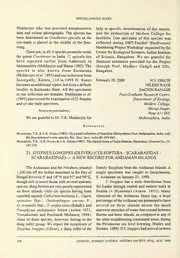
Sisyphus Longipes (Oliver) (Coleoptera : Scarabaeidae : Scarabaeinae): a new Record for Andaman Islands PDF
Preview Sisyphus Longipes (Oliver) (Coleoptera : Scarabaeidae : Scarabaeinae): a new Record for Andaman Islands
MISCELLANEOUS NOTES Mukherjee who was provided morphometric help in specific determination of this mantis, data and colour photographs. The species has and the authorities of Modern College for been determined as Creobroter apicalis as the facilities. One specimen of this species was eye-mark is placed in the middle of the fore- collected during DBT-Funded ‘Biodiversity wing. MonitoringProjectWorkshop’ organizedbythe Thereare, inall, 6 speciespresentlyunder Centre forEcological Sciences, Indian Institute the genus Creobroter in India. C. apicalis has of Science, Bangalore. We are grateful for been reported earlier from Ambenali in financial assistance provided for the Project Maharashtra (Mukherjee and Hazra 1983). The through Prof. Madhav Gadgil and IISc, species is also known from Karnataka Bangalore. (Mukherjee etal. 1995) andourcollection from Santegully, Kumta, (14.ix.1998 N. Rane) February 29, 2000 H.V.GHATE becomesanadditionalreport,butfromadefinite NILESH RANE locality in Karnataka State. All the specimens SACHIN RANADE in our collection are females. Mukherjee et al Post-Graduate Research Centre, (1995)alsorecordtheexaminationof23 females Department ofZoology, and ofone male specimen. Modern College, ShivajiNagar, Acknowledgements Pune 411 005, We are gratefultoDr. T.K. Mukherjeefor Maharashtra, India. References Mukherjee,T.K.&A.K.Hazra(1983):OnasmallcollectionofMantidae(Dictyoptera)fromMaharashtra,India,with thedescriptionofanewspecies.Rec.Zool. Surv.India80:459-465. Mukherjee,T.K.,A.K.Hazra&A.K.Ghosh(1995):ThemantidfaunaofIndia(Insecta:Mantodea).OrientalIns. 29: 185-358. 21.SSCIASRYPAHBUASELIONNAGEI)P—ESA(NOLEIWVERRE)C(OCRODLEFOOPRTAERNAD:ASMCAANRAIBSALEANIDDSAE : The Andamans and the Nicobars, situated Family Sisyphini from the Andaman Islands. A 1,200 km offthe Indian mainland in the Bay of single specimen was caught in Garacharma, Bengalbetween 6°and 14°N and91°and 94°E, S. Andaman on January 25, 1998. thoughrichininsectfaunawithseveral endemic S. longipes has a wide distribution from species,dungbeetlesareverypoorlyrepresented Sri Lanka through central and eastern India to on these islands. Only six species having been Burma (= Myanmar) (Arrow 1931). Many reported,namelyCatharsiusmolossusL., Copris elements of the Andaman fauna (eg. a large spinator Har., Onthophagus cervus F., percentageoftheavifauna)arepresumedtohave O. orientalis Har., O. unifasciatus (Schall.), and arrived on these islands across the much Paraphytus andamanus Arrow (Arrow 1931, narrowerstretchesofwaterthatexistedbetween Veenakumari and Prashanth Mohanraj 1994). Burma andthese islands, as comparedto any of None of these species, however, belong to the the otherneighbouring continental areas, during dung roller group. We report the occurrence of the Pleistocene sea level lowering (Ripley and Sisyphus longipes (Oliver), a dung roller ofthe Beehler 1989).IfS.longipeshadarrivedonthese 298 JOURNAL. BOMBAYNATURAL HISTORYSOCIETY. 97(2), AUG. 2000 MISCELLANEOUS NOTES 1 Plate (length) mm 30 size actual $, apicalis Creobroter 1: Fig. apicalis Creobroter al. et Ghate H.V. JOURNAL, BOMBAY NATURAL HISTORY SOCIETY, 97(2), AUG. 2000 299 MISCELLANEOUSNOTES islands during that period and established itself ofthis species on the Andaman Islands. here, then it must be a very rare species or one with cryptic habits, as we have not found any AcKNOWLEDGEMENT more specimens during ourdung beetle surveys on these islands. This is likely as S. longipes is We thank Dr. A. K. Bandyopadhyay, knownto inhabitobscureplaceslikethenestsof Director, CentralAgriculturalResearchInstitute ants (Arrow, 1931). In case the species has not for encouragement. yet established itself on these islands, the specimencollectedbyusmaybepartofthewaif June 26, 1999 K. VEENAKUMARI biota arriving on these islands or a vagrant,just PRASHANTHMOHANRAJ like the dozen or so species ofbutterflies that Central Agricultural Research Institute, Ferrar (1948) identified as vagrants on these Port Blair 744 101, islands. Further studies can establish the status Andaman andNicobarIslands, India. References Arrow,G.J.(1931):TheFaunaofBritishIndiaincluding affinities ofthe Andaman and Nicobar Islands. CeylonandBurma.Coleoptera:Lamellicornia,III J. Biogeogr.16:323-332. (Coprinae).TaylorandFrancis,London,pp.428. Veenakumari, K. & Prashant Mohanraj (1994): Ferrar, M. L., (1948): Thebutterfliesofthe Andamans Onthophagus unifasciatus F. (Coleoptera: and Nicobars. J. Bombay nat. Hist. Soc. 47: Scarabaeidae: Scarabaeinae) - A new record for 470-491. AndamanIslands.J.Bombaynat.Hist.Soc. 91(1): Ripley,S.D.&B.M.Beehler(1989):Ormthogeographic 153-154. LARGE SCALE EMERGENCE AND MIGRATION OF THE COMMON 22. EMIGRANTBUTTERFLIES CATOPSILIA POMONA (FAMILY PIERIDAE) : During my journey on June 17, 1999, Emigrants. It was noted that the swarm of through the forest tracts between Mahasamund butterflies seemed to be on a northward (Dist. H.Q.) to Tumgaon and Jhalap (NH 6), migration. During my returnjourney (1600 hrs Madhya Pradesh, no less than five to six to 1700 hrs) the sky was heavily clouded and it thousand Common Emigrant butterflies wasdrizzling;hardly200to300butterflieswere (Catopsiliapomona)wereobservedflyingsouth seen on the same route. to north at a moderate height of0.60 m to 4 m Butterflies usually migrate northward to above ground. At that time (1230 hrs to 1330 avoid the southwest monsoon. In this case, the hrs) the sun was shining. This forest tract migration may be due to premonsoon rain in surrounds a big man-made reservoir named the month of June. The locality had moderate Kodar and has teak plantation patches in rains in the past 15 days, but the monsoon was between the forest, onNH 6. yet to set in. The large scale emergence and Interestingly,intheteak(Tectonagrandis) migrationappearedtohavestartedthreemonths patches, the butterflies were almust absent, in advance. Also, the marked absence of the whereas in mixed deciduous forestpatches they species in teak patches was interesting. were present in large numbers. November 999 A.M.K. BHAROS 18, 1 A few Mottled Emigrants (Catopsilia B-101, GayatriNagar, pyranthe and Lime Butterflies Papilio POShankerNagar, ) ( demoleus) were also flying with the Common Raipur 492 001, Madhya Pradesh, India. JOURNAL, BOMBAYNATURAL HISTORYSOCIETY, 97(2), AUG. 2000 301
